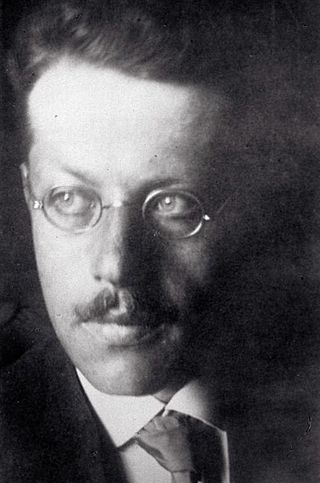
Franz Rosenzweig was a German theologian, philosopher, and translator.
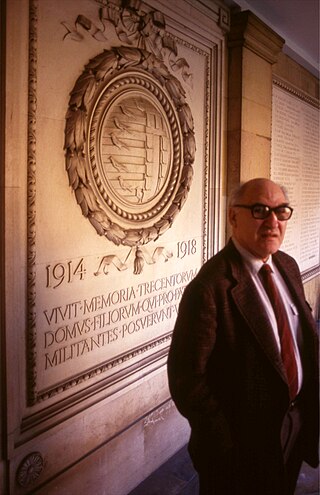
Gerhard "George" Lachmann Mosse was an American historian, who emigrated from Nazi Germany to Great Britain, and then to the United States. He was professor of history at the University of Iowa, the University of Wisconsin–Madison, and also in Israel, at the Hebrew University of Jerusalem. Best known for his studies of Nazism, he authored more than 25 books on topics as diverse as constitutional history, Protestant theology, and the history of masculinity. In 1966, he and Walter Laqueur founded The Journal of Contemporary History, which they co-edited.
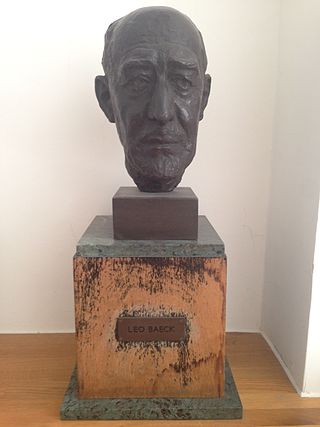
Leo Baeck was a 20th-century German rabbi, scholar, and theologian. He served as leader of Reform Judaism in his native country and internationally, and later represented all German Jews during the Nazi era. After the Second World War, he settled in London, in the United Kingdom, where he served as the chairman of the World Union for Progressive Judaism. In 1955, the Leo Baeck Institute for the study of the history and culture of German-speaking Jewry was established, and Baeck was its first international president. The Leo Baeck Medal has been awarded since 1978 to those who have helped preserve the spirit of German-speaking Jewry in culture, academia, politics, and philanthropy.

The history of the Jews in Germany goes back at least to the year 321, and continued through the Early Middle Ages and High Middle Ages when Jewish immigrants founded the Ashkenazi Jewish community. The community survived under Charlemagne, but suffered during the Crusades. Accusations of well poisoning during the Black Death (1346–53) led to mass slaughter of German Jews and they fled in large numbers to Poland. The Jewish communities of the cities of Mainz, Speyer and Worms became the center of Jewish life during medieval times. "This was a golden age as area bishops protected the Jews resulting in increased trade and prosperity."
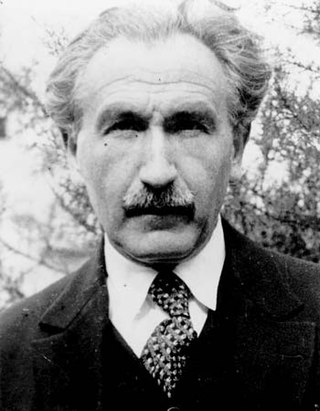
Hugo Bergmann was an Israeli philosopher, born in Prague.

Felix Weltsch, was a German-speaking Jewish librarian, philosopher, author, editor, publisher and journalist. A close friend of Max Brod, Ludwig Winder and Franz Kafka, he was one of the most important Zionists in Bohemia.
Max Naumann was the founder of Verband nationaldeutscher Juden, which called for the elimination of Jewish ethnic identity through Jewish assimilation. The league was outlawed by the Nazis on 18 November 1935.
Eva Gabriele Reichmann was an eminent German historian and sociologist. From 1945 on she conducted research on anti-Semitism. Reichmann was Jewish.

Ephraim Moses Lilien was an art nouveau illustrator and printmaker particularly noted for his art on Jewish themes. He is sometimes called the "first Zionist artist."

Robert Weltsch was a journalist, editor and prominent Zionist.

The Leo Baeck Institute, established in 1955, is an international research institute with centres in New York City, London, Jerusalem and Berlin, that are devoted to the study of the history and culture of German-speaking Jewry. The institute was founded in 1955 by a consortium of influential Jewish scholars including Hannah Arendt, Martin Buber and Gershom Scholem. The Leo Baeck Medal has been awarded since 1978 to those who have helped preserve the spirit of German-speaking Jewry in culture, academia, politics, and philanthropy.

Mark. H. Gelber is an American-Israeli scholar of comparative literature and German-Jewish literature and culture. He received his B.A. magna cum laude and with high honors in Letters and German. He also studied at the University of Bonn, the University of Grenoble, and Tel Aviv University. He was accepted for graduate studies as a Lewis Farmington Fellow in the Humanities and Social Sciences at Yale University and he received his M.A., M.Phil., and Ph.D. from Yale University. In 1980 he accepted an appointment as post-doctoral lecturer at Ben-Gurion University of the Negev, Beer Sheva, in the Department of Foreign Literatures and Linguistics. Except for guest professorships and research fellowships abroad, he has been affiliated there since that time. His research topics include: German-Jewish literature and culture, the literature of exile, cultural Zionism, early Zionist literature and journalism, literary anti-Semitism, autobiography and biography, and literary reception. He lectures frequently at international meetings and conferences in Israel, Europe, China, and the United States. He is presently professor emeritus with active researcher status.

Werner van der Zyl was a rabbi in Berlin and in London, where he came in 1939 as a refugee rabbi from Germany. He was the prime mover and first director of studies of the Jewish Theological College of London. The college was inaugurated in 1956 and was renamed Leo Baeck College shortly afterwards at his suggestion.

The Leo Baeck Institute New York (LBI) is a research institute in New York City dedicated to the study of German-Jewish history and culture, founded in 1955. It is one of three independent research centers founded by a group of German-speaking Jewish émigrés at a conference in Jerusalem in 1955. The other Leo Baeck institutes are Leo Baeck Institute Jerusalem and Leo Baeck Institute London, and the activities of all three are coordinated by the board of directors of the Leo Baeck Institute. It is also a founding partner of the Center for Jewish History, and maintains a research library and archive in New York City that contains a significant collection of source material relating to the history of German-speaking Jewry, from its origins to the Holocaust, and continuing to the present day. The Leo Baeck Medal has been awarded by the institute since 1978 to those who have helped preserve the spirit of German-speaking Jewry in culture, academia, politics, and philanthropy.

Arno Nadel was a Lithuanian musicologist, composer, playwright, poet, and painter.
Michael Brenner is a German historian who researches and publishes on the history of Jews and Israel. Brenner has authored eight books on Jewish History, which were translated into twelve languages and is the editor and co-editor of eighteen books. He holds teaching positions at both the Ludwig Maximilian University of Munich and the American University.
The Leo Baeck Institute London is a research institute dedicated to the study of German-Jewish history, politics and culture, founded in 1955. It belongs to the international Leo Baeck Institute with further research centres in New York City, Berlin and Jerusalem.
Margarete Susman was a German-Jewish poet, writer, and critic who lived much of her life in Switzerland. The author of hundreds of essays, five collections of poetry, and notable literary-critical works, she distinguished herself as a philosophical writer addressing vital questions in literature, politics, culture and religion. Her 1946 work Das Buch Hiob und das Schicksal des jüdischen Volkes (1946), a reflection on Jewish history through the lens of the Biblical book of Job, was one of the earliest postwar Jewish theological responses to the Holocaust.
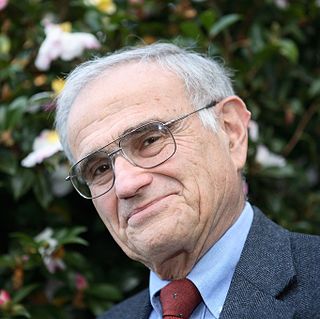
Michael Albert Meyer is a German-born American historian of modern Jewish history. He taught for over 50 years at the Hebrew Union College-Jewish Institute of Religion in Cincinnati, Ohio. He is currently the Adolph S. Ochs Emeritus Professor of Jewish History at that institution. He was one of the founders of the Association for Jewish Studies, and served as its president from 1978–80. He also served as International President of the Leo Baeck Institute from 1992–2013. He has published many books and articles, most notably on the history of German Jews, the origins and history of the Reform movement in Judaism, and Jewish people and faith confronting modernity. He is a three-time National Jewish Book Award winner.

Milgroim. Journal for Art and Literature was a Yiddish cultural magazine that was published between 1922 and 1924 in Berlin by Rimon. At the same time, the Hebrew language magazine Rimon was published in a similar format. Milgroym and rimon means "pomegranate" in Yiddish and Hebrew, respectively.















